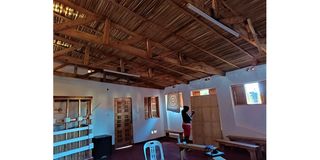Prime
Using papyrus as a roofing material

The papyrus ceiling at 8m Skilling Centre. PHOTO | PROMISE TWINAMUKYE
What you need to know:
- Today, papyrus is making a comeback as a popular roofing material, because it is affordable, versatile and helps in preserving the environment
Two thousand years ago, papyrus was the most popular writing material in the world. Exclusively made by the Egyptians, who had access to the papyrus reeds that grew abundantly on the banks of River Nile, it was replaced by paper as a writing material. Apart from writing, papyrus was also used as a roofing material and source of fuel.
Today, papyrus is making a comeback as a popular roofing material, especially in eco-friendly entertainment and hospitality establishments because it is affordable, versatile and helps in preserving the environment.
Hans Mwesigwa, the coordinator at 8m Skilling Centre, a centre that equips young people with construction skills, is one of the people who have embraced papyrus as a roofing material. With more people preferring modern roofs, thatching as a construction skill lost demand and therefore, fewer people were inclined to learn it.
However, with the material gaining popularity, it is important that there are people with the right skills to satisfy the demand and do the work perfectly.
Mwesigwa knew something had to be done about this and that is why he chose to use papyrus as a ceiling. Instead of using it as the sole roofing material or as part of the ceiling.
“Choosing a papyrus ceiling did not only give the learners an opportunity to learn how to work with it but it has also come with more benefits such as noise insulation especially when it rains and cooling down the room on hot days,” Mwesigwa says.
According to Mwesigwa, when done well, papyrus can look very stylish and is highly functional. “The beauty of working with papyrus is that it gives one several options that can enliven any interior, regulate heat all at an affordable cost,” he says.
Using papyrus either as a primary roofing material or as a ceiling will also give you a self-regulating house because it is remains warm during the cold season and cool during the hot one.
Papyrus has come a long way since when it was first used by our ancestors.
“Before iron sheets became easily affordable, papyrus was a highly valued material, only available to the well-off such as the parish chief or public places such as places of worship and administrative offices,” Mwesigwa says.
Mwesigwa used papyrus to compliment the iron sheets but it can work well with many other materials.
Aesthetics
They say beauty lies in the eyes of the beholder. When working with papyrus, this craft not only depends on the owner of a property, but also the skills of the artisan.
“If a good ceiling is done in papyrus, it can last for more than 30 years depending on how it is fixed. Once papyrus is harvested, drying it properly before use increases its durability. The damp can cause decay,” he says.
Downside
Papyrus roofs are highly flammable and susceptible to leaking, which makes them the least favourable roofing option for commercial and permanent structures. Because it is a perishable material, if not well maintained (or treated before installation), it may harbour rodents, insects and that may become a health hazard.


